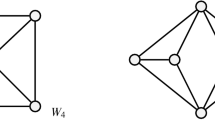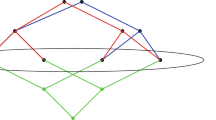Abstract
A fundamental result of Mader from 1972 asserts that a graph of high average degree contains a highly connected subgraph with roughly the same average degree. We prove a lemma showing that one can strengthen Mader’s result by replacing the notion of high connectivity by the notion of vertex expansion.
Another well known result in graph theory states that for every integer t there is a smallest real c(t), such that every n-vertex graph with c(t) n edges contains a K t -minor. Fiorini, Joret, Theis and Wood asked whether every n-vertex graph G that has at least (c(t)+ε)n edges, must contain a K t -minor of order at most C(ε) logn. We use our extension of Mader’s theorem to prove that such a graph G must contain a K t -minor of order at most C(ε) lognlognlogn. Known constructions of graphs with high girth show that this result is tight up to the log logn factor.
Similar content being viewed by others
References
N. Alon, P. Seymour and R. Thomas: A separator theorem for nonplanar graphs, J. Amer. Math. Soc. 3 (1990), 801–808
S. Arora, B. Barak and D. Steurer: Subexponential algorithms for unique games and related problems, Proc of FOCS 2010, 563–572
B. Bollobás and A. Thomason: Highly linked graphs, Combinatorica 16 (1996), 313–320
R. Diestel: Graph Theory, (4th Edition), Springer, Heidenberg, 2012
V. Dujmovic, D. J. Harvey, G. Joret, B. Reed and D. R. Wood: A linear-time algorithm for finding a complete graph minor in a dense graph, Manuscript 2012
S. Fiorini, G. Joret, D. O. Theis and D. R. Wood: Small minors in dense graphs, European J. Combinatorics 33 (2012), 1226–1245
O. Goldreich and D. Ron: A sublinear bipartiteness tester for bounded degree graphs, Combinatorica 19 (1999), 335–373
S. Hoory, N. Linial and A. Wigderson: Expander graphs and their applications, Bull. AMS 43 (2006), 439–561
J. Kleinberg and R. Rubinfeld: Short paths in expander graphs, Proc. 37t h Symposium on Foundations of Computer Science (FOCS), IEEE Comput. Soc. Press, 1996, 86–95
J. Kmlós and M. Simonovits: Szemerédi’s Regularity Lemma and its applications in graph theory, in: Combinatorics, Paul Erdos is Eighty, Vol II (D. Miklós, V. T. Sós, T. Szőnyi eds.), János Bolyai Math. Soc., Budapest (1996), 295–352
A. Kostochka and L. Pyber: Small topological complete subgraphs of dense" graphs, Combinatorica 8 (1988), 83–86
A. Kostochka: Lower bound of the Hadwiger number of graphs by their average degree, Combinatorica 4 (1984), 307–316
M. Krivelevich and B. Sudakov: Pseudo-random graphs, in: More sets, graphs and numbers, E. Gyori, G. O. H. Katona and L. Lovász, Eds., Bolyai Society Mathematical Studies Vol. 15 (2006), 199–262
M. Krivelevich and B. Sudkov: Minors in expanding graphs, Geometric and Functional Analysis 19 (2009), 294–331
A. Lubotzky, R. Phillips and P. Sarnak: Ramanujan graphs, Combinatorica 8 (1988), 261–277
W. Mader: Homomorphieeigenschaften und mittlere kantendichte von graphen, Math. Ann. 174 (1967), 265–268
W. Mader: Homomorphiesäatze füur graphen, Math. Ann. 178 (1968), 154–168
J. S. Myers: Graphs without large complete minors are quasi-random, Combinatorics, Probability and Computing 11 (2002), 571–585
S. Plotkin, S. Rao and W. Smith: Shallow excluded minors and improved graph decompositions, Proc. 5th ACM-SIAM Symposium on Discrete Algorithms (SODA), ACM, New York, 1994, 462–470
N. Robertson and P. D. Seymour: Graph minors XIII, the disjoint paths problem, J. Combin. Theory Ser. B 63 (1995), 65–110
A. Shapira and B. Sudakov: Small Complete Minors Above the Extremal Edge Density, arXiv: 1208.3568
E. SzemerÉdi: Regular partitions of graphs, in: Proc. Colloque Inter. CNRS (J. C. Bermond, J. C. Fournier, M. Las Vergnas and D. Sotteau, eds.), 1978, 399–401
A. Thomason: An extremal function for contractions of graphs, Math. Proc. Cambridge Philos. Soc. 95 (1984), 261–265
A. Thomason: The extremal function for complete minors, J. Combin. Theory Ser. B 81 (2001), 318–338
L. Trevisan: Approximation algorithms for unique games, Theory of Computing 4 (2008), 111–128.
Author information
Authors and Affiliations
Corresponding author
Additional information
Supported in part by NSF Grant DMS-0901355, ISF Grant 224/11 and a Marie-Curie CIG Grant 303320.
Research supported in part by NSF grant DMS-1101185, by AFOSR MURI grant FA9550-10-1-0569 and by a USA-Israel BSF grant.
Rights and permissions
About this article
Cite this article
Shapira, A., Sudakov, B. Small complete minors above the extremal edge density. Combinatorica 35, 75–94 (2015). https://doi.org/10.1007/s00493-015-3013-2
Received:
Published:
Issue Date:
DOI: https://doi.org/10.1007/s00493-015-3013-2




